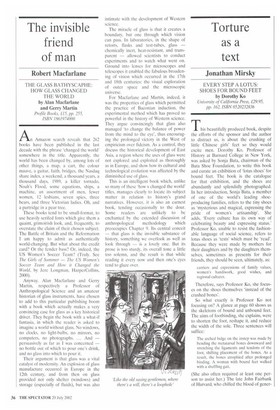The invisible friend of man
Robert Macfarlane
THE GLASS BATHYSCAPHE: HOW GLASS CHANGED THE WORLD by Man Macfarlane and Gerry Martin Profile Books, £15, pp. 255, ISBN 1861974000 An Amazon search reveals that 262 books have been published in the last decade with the phrase 'changed the world' somewhere in the title. Apparently, the world has been changed by, among lots of other things, a map, a cart, the colour mauve, a guitar, faith, bridges, the Nasdaq share index, a weekend, a thousand years, a thousand days, 1989, a killer tornado, Noah's Flood, some equations, ships, a machine, an assortment of men, fewer women, 12 lesbians, seven spies, three bears, and three Victorian ladies. Oh, and a partridge in a pear tree.
These books tend to be small-format, to use heavily serifed fonts which give them a quaint, grimoirish look, and, frequently, to overstate the claim of their chosen subject. The Battle of Britain and the Reformation I am happy to admit as authentically world-changing. But what about the credit card? Or the fender bass? Or, indeed, the US Women's Soccer Team? (Truly. See The Girls of Summer — The US Women's Soccer Team and How it Changed the World, by Jere Longman, HarperCollins, 2000).
Anyway. Alan Macfarlane and Gerry Martin, respectively a Professor of Anthropological Science and an amateur historian of glass instruments, have chosen to add to this particular publishing boom with a book which actually makes a very convincing case for glass as a key historical driver. They begin the book with a what-if fantasia, in which the reader is asked to imagine a world without glass. No windows, no clocks, no light-bulbs, no mirrors, no computers, no photographs. ... And — persuasively as far as I was concerned — no bottle out of which to pour one's drink, and no glass into which to pour it.
Their argument is that glass was a vital catalyst of modernity. An explosion of glass manufacture occurred in Europe in the 12th century, and from then on glass provided not only shelter (windows) and storage (especially of fluids), but was also intimate with the development of Western science.
The miracle of glass is that it creates a boundary, but one through which vision can pass. In laboratories, in the shape of retorts, flasks and test-tubes, glass — chemically inert, heat-resistant, and transparent — allowed scientists to conduct experiments and to watch what went on. Ground into lenses for microscopes and telescopes it enabled the fabulous broadening of vision which occurred in the 17th and 18th centuries: the visual exploration of outer space and the microscopic universe.
For Macfarlane and Martin, indeed, it was the properties of glass which permitted the practice of Baconian induction, the experimental method which has proved so powerful in the history of Western science. They argue convincingly that glass also managed 'to change the balance of power from the mind to the eye', thus encouraging the prolonged victory in the West of empiricism over fideism. As a control, they discuss the historical development of East Asia, a region where the uses of glass were not explored and exploited as thoroughly as in Europe, and show how its cultural and technological evolution was affected by the diminished use of glass.
This is an intelligent book which, unlike so many of these 'how x changed the world' titles, manages clearly to locate its subject matter in relation to history's grand narratives. However, it is also an earnest book, tending occasionally to the dour. Some readers are unlikely to be enchanted by the extended discussion of
anthropological methodology which preoccupies Chapter 9. Its central conceit — that glass is the invisible substance of history, something we overlook as well as look through — is a lovely one. But its prose is too sturdy, its overall tone a little too solemn, and the result is that while reading it every now and then one's eyes tend to glaze over.


























































 Previous page
Previous page